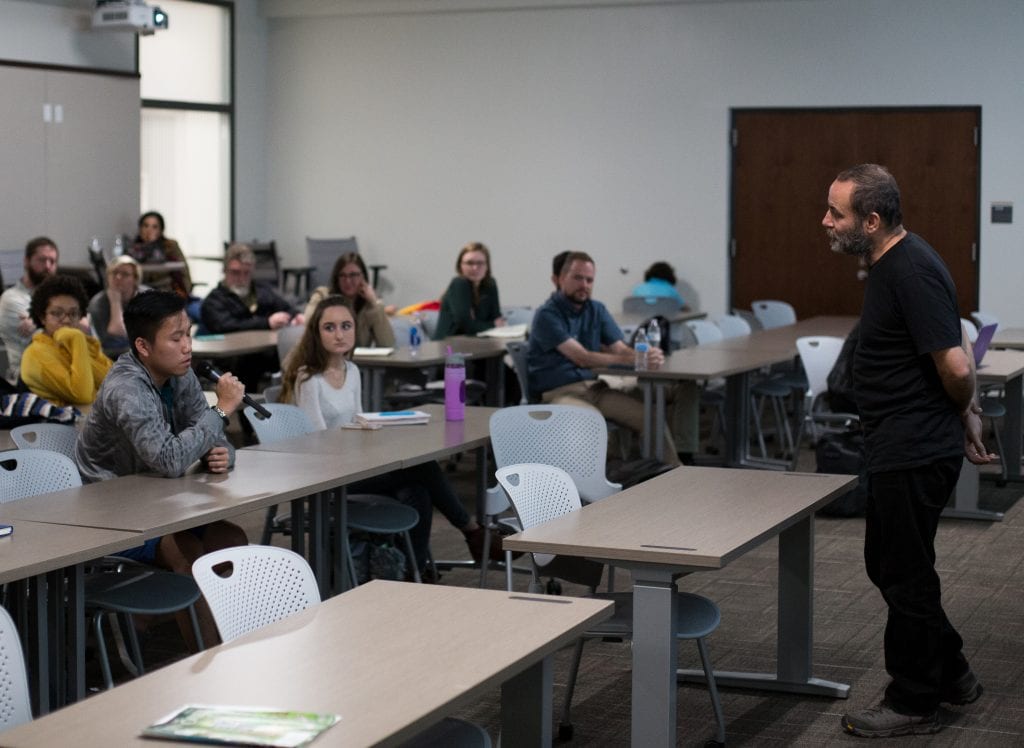Artist Brings Perspective On Iraqi Turmoil

On Feb. 1, 2019, Kurdish Political Studies Program (KPSP) and School of Visual Arts and Design hosted a guest lecture by Berlin-based, internationally renowned artist Hiwa K. Born and raised in northern Iraq’s Kurdistan region, Hiwa K’s award-winning work has been internationally exhibited in venues such as Manifesta 7 (2008), the Venice Biennale (2015), and documenta14 (2017).
The event started with the screening of one of K’s video artworks, “A View from Above”. It is a 12-minute close-up shooting of a model depicting a destroyed German town right after World War II. The narrative’s accompanying images tells the story of M, an asylum-seeker from Iraqi Kurdistan who comes from a town considered as ‘safe’ by the UN. M is a deserter from the army whose application is rejected. When he is set to be deported back to his country — which was then still ruled by a dictator — M decides to make another application, this time pretending he comes from an ‘unsafe’ town called J. During his interview, the official is impressed by the answers M give which demonstrate his knowledge of J as it is seen from above. The narrator goes on to tell how the ‘safe zone’ within Iraq (created by the division of the Kurdish autonomous region) was a fictitious place in the minds of European bureaucrats, with no real safety to be found there. It also tells how people from J are denied asylum as their descriptions of the town are based on their experience on the ground, whereas the officials demand the look from above to the taste of their Western eye.
After the screening, Hiwa K introduced himself and started the talk by explaining how his background influenced his art and his persona as an artist. He mentioned a red security building only meters away from his middle school. He would pass by this building every day for six years where Iraqi soldiers were torturing prisoners. Those who survived tortures would face life imprisonments. There were also many children born of rape in this building. Emphasizing the personal need of translating his memoirs into writing and art, he made the public watch another video art (Moon Calendar) in which he tap dances in that old prison while listening to his heart beats on stethoscope at the same time. The last screening of the event featured an intervention by the artist and group of local activists in Suleymaniya in 2011, following the civil unrest in the city. Demanding transparency and participation, protestors raised their voice against the local government, which would later prohibit legal demonstration. In the video, we see activists bringing their favorite books to the public square and burning them under magnifiers.
During the lively question-and-answer session after the talk, the artist explained how each work starts to grow in his mind and he in a way becomes the midwife to the material in his head. He noted that even though his starting points are always personal stories, somewhere along the path, it turns into a collective story. He concluded his talk with rather pessimistic remarks about the future of the globe, the possible effects of climate change and the environmental refugee crisis. Criticizing art for not being political enough, he noted that he started losing faith in his work. “We have so long been listening to the egoistic Western mind, maybe it is time we listen to the heart” he stated.
